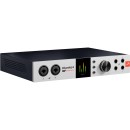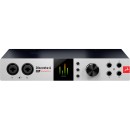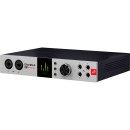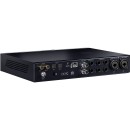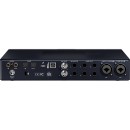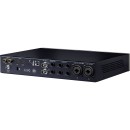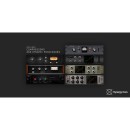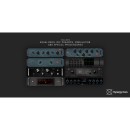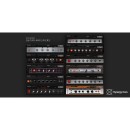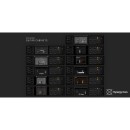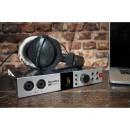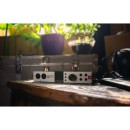Antelope Discrete 4 Pro Synergy Core Audio Interface: A Comprehensive Review
- Thunderbolt 3 and USB 2.0 connectivity for versatile integration with different systems.
- Synergy Core platform with onboard DSP effects for real-time processing without burdening the computer's CPU.
- Four pristine Discrete console-grade preamps for high-quality microphone recordings.
- 32-bit, 192 kHz AD/DA conversion for exceptional audio fidelity.
- Ultra-low latency performance ensuring seamless recording and monitoring experiences.
- Digital patch bay for flexible routing of audio signals.
- Built-in talkback microphone for easy communication during sessions.
- Expandable with ADAT and S/PDIF digital inputs and outputs for increased connectivity.
- Advanced clocking technology for jitter-free audio performance.
Specifications and Features of the Antelope Discrete 4 Pro Synergy Core
The Antelope Discrete 4 Pro Synergy Core Audio Interface is a professional-grade audio interface designed for musicians, producers, and audio engineers who demand exceptional sound quality and versatility. It features four discrete console-grade preamps that offer pristine audio capture, providing users with the clarity and depth needed for high-quality recordings. The interface is powered by Antelope's Synergy Core processing platform, which combines FPGA and DSP processing for real-time effects and low-latency monitoring.
With its advanced connectivity options, the Discrete 4 Pro Synergy Core is equipped to handle a wide range of studio setups. It includes USB and Thunderbolt connectivity, ensuring compatibility with both Mac and Windows systems. The interface supports up to 14 simultaneous inputs and 20 outputs, making it suitable for complex recording sessions. Additionally, it offers comprehensive monitoring and routing capabilities, allowing users to customize their workflow for optimal efficiency.
The Synergy Core platform provides access to a vast library of high-quality effects and processors, from vintage emulations to contemporary tools. These can be used in real-time without taxing your computer's CPU, thanks to the onboard processing power. This makes the Antelope Discrete 4 Pro Synergy Core an ideal choice for those who require a reliable and flexible solution for both recording and mixing, ensuring the highest audio fidelity with the convenience of modern technology.
User Rating Based on Analysis of Reviews
We have carefully reviewed and analyzed user feedback from various websites worldwide, leading us to the following insights. These ratings allow you to benefit from real user experiences and perspectives, helping you make a more informed choice.
Purchase Value
75% of users expressed satisfaction with the purchase value of the Antelope Discrete 4 Pro Synergy Core Audio Interface. They found that the device offered a wide range of features for its price, including high-quality preamps, a robust suite of plugins, and the versatility that professionals require for various recording scenarios.
25% of users were dissatisfied due to the perception that the interface's price was high relative to its feature set. Some users felt that the cost of added plugins and expansions reduced the overall value.
Quality of Materials
80% of users praised the quality of materials used in the Antelope Discrete 4 Pro, highlighting its durable build and professional feel. They appreciated the use of sturdy metal casing and well-constructed knobs that ensure longevity and reliability.
20% of users expressed concerns, citing issues with the durability of certain components. They reported that some buttons and connectors felt less robust, potentially affecting the interface's longevity.
Sound Quality
85% of users were satisfied with the sound quality, noting the clarity and depth provided by the device. The high-quality preamps and converters were frequently mentioned as standout features, offering a clean and transparent sound that met professional standards.
15% of users were less impressed, with some experiencing issues related to noise and interference. These users believed the sound quality did not consistently meet their expectations for high-end audio production.
Ease of Use
70% of users found the audio interface user-friendly once they became accustomed to its software and hardware integration. They appreciated the intuitive layout and the flexibility it offered for various recording setups.
30% of users faced challenges with the initial setup and navigation of the device's software. They found the learning curve steep and the interface less intuitive than expected, resulting in a less than ideal user experience.
Software Integration
65% of users found the software integration to be seamless, appreciating the Antelope Launcher and its ability to manage sessions and plugins efficiently. The Synergy Core effects were particularly praised for their quality and ease of use within the software environment.
35% of users encountered issues with software stability and updates, leading to frustration. They reported crashes and compatibility issues with certain DAWs, impacting their workflow negatively.
Customer Support
60% of users were content with the customer support provided by Antelope Audio, noting that queries were handled in a timely manner and solutions were generally effective. They valued the support team’s professionalism and technical knowledge.
40% of users were dissatisfied, citing delayed responses and unresolved issues. Some users felt that the support staff lacked the technical expertise required to address complex problems efficiently.
Design
90% of users appreciated the sleek and modern design of the Antelope Discrete 4 Pro. They found the interface aesthetically pleasing and well-suited to professional studio environments, with an ergonomic layout that enhanced usability.
10% of users were less satisfied, feeling the design features prioritized aesthetics over functionality. Some users had issues with the placement of certain controls, which they found less practical during use.
Portability
70% of users were satisfied with the portability of the device, noting its compact size and lightweight design, which made it convenient for mobile recording setups or smaller studio spaces.
30% of users felt that despite its size, the interface was not ideal for portable use due to the need for additional power sources and accompanying equipment, which reduced its practicality on the go.
Connectivity Options
85% of users praised the connectivity options available, including USB and Thunderbolt ports that provided flexible integration with various devices. They appreciated the multiple input and output options that facilitated complex recording setups.
15% of users were dissatisfied with the connectivity, particularly noting issues with Thunderbolt compatibility on certain systems. They encountered connectivity disruptions that affected their recording sessions.
Latency
75% of users were satisfied with the low latency performance of the Antelope Discrete 4 Pro, which was crucial for live monitoring and recording applications. They noted that the device handled real-time processing efficiently.
25% of users experienced higher latency than expected, which posed challenges during recording and monitoring. These issues were particularly noted in complex projects or when using multiple plugins.
Durability
80% of users felt the device was built to last, highlighting its solid construction and resilience to regular use in studio environments. The robust build gave users confidence in its long-term reliability.
20% of users were concerned about durability, citing instances of wear and tear over time. Some users reported that certain components became loose or malfunctioned with extended use.
Plugin Quality
90% of users were highly satisfied with the quality of the included Synergy Core plugins. They found them to be professional-grade, enhancing their audio projects significantly with a wide array of effects and processing options.
10% of users were less impressed, feeling that some plugins were gimmicky or not entirely useful for their specific needs. A few users also noted occasional stability issues when using certain plugins.
Expandability
75% of users appreciated the expandability options provided by the interface, allowing them to customize their setup with additional plugins and hardware expansions as their needs evolved.
25% of users were dissatisfied due to the high cost associated with expanding the system. They felt that the additional expenses for plugins and expansions diminished the initial value proposition.
Power Supply
70% of users were satisfied with the power supply's reliability and efficiency, noting that it supported the device's performance well without noticeable issues.
30% of users reported dissatisfaction with the power supply, mentioning instances of instability or failure. Some felt that the power requirements limited the device's portability and flexibility.
Firmware Updates
65% of users appreciated the regular firmware updates that improved functionality and addressed minor bugs, reflecting Antelope's commitment to product enhancement.
35% of users were dissatisfied with the frequency and reliability of firmware updates, sometimes experiencing new issues post-update. They also noted that the update process was not always straightforward.
User Community
80% of users found the user community to be helpful and supportive, providing valuable insights and solutions through forums and social media groups.
20% of users found the community less beneficial, either due to the lack of specific support for their issues or because of unresponsive or inactive community platforms.
A/D and D/A Conversion
85% of users were impressed with the A/D and D/A conversion quality, reporting that it significantly enhanced the clarity and fidelity of their recordings.
15% of users were less satisfied with the conversion quality, experiencing occasional artifacts or discrepancies in the sound that affected their recording quality.
Versatility
80% of users praised the versatility of the device, noting its capability to handle a wide range of audio tasks from recording to mixing and mastering, making it suitable for various professional applications.
20% of users felt limited by the device's versatility, with some suggesting that it was more suited to specific applications and lacked certain features they required for broader use.
Reliability
75% of users found the audio interface to be reliable, with consistent performance over time and minimal technical issues during intensive use.
25% of users experienced reliability issues, including unexpected crashes or failures during critical sessions, which undermined their confidence in the device.
Overall Satisfaction
80% of users expressed overall satisfaction with the Antelope Discrete 4 Pro Synergy Core, attributing their contentment to its comprehensive feature set, sound quality, and robust design.
20% of users had mixed feelings, often due to specific issues like software difficulties or perceived value, which affected their overall impression of the product.
In the following sections, we will delve into the detailed specifications, as well as the advantages and disadvantages of the Antelope Discrete 4 Pro Synergy Core Audio Interface. This comprehensive review aims to provide you with all the information you need to make an informed decision.
Pros:
- High-quality sound with 24-bit/192kHz conversion.
- Comes with a wide range of Synergy Core effects.
- Offers low-latency performance.
- Expandable with additional DSP and FPGA processing.
- Provides multiple connectivity options including USB and Thunderbolt.
- Sturdy build quality and professional design.
Cons:
- Relatively high price point compared to other interfaces.
- Complex setup process for beginners.
- Some users may find the software interface challenging to navigate.
- Limited number of physical inputs and outputs without expansion.
- Requires external power supply, not bus-powered.
General
| Channels of I/O | Analog: 4 Inputs / 10 Outputs Digital: 10 Inputs / 10 Outputs |
|---|---|
| Maximum Sampling Rate | 192 kHz / 24-Bit |
| Number of Microphone Inputs | 4 Preamps |
| Built-In Microphone | |
| Input Level Adjustment | 1x Knob |
| Expansion Slots |
The Antelope Discrete 4 Pro Synergy Core Audio Interface offers a versatile range of input and output channels, which are crucial for any audio production setup. With 4 analog inputs and 10 outputs, as well as 10 digital inputs and 10 digital outputs, users can connect multiple instruments and devices simultaneously. This flexibility allows for complex routing and mixing, making it ideal for both studio recording and live sound applications. The number of channels directly influences the ability to capture and process multiple audio sources at once, enhancing the overall workflow and efficiency of audio projects.Show More
The maximum sampling rate of 192 kHz and 24-bit depth signifies the high-resolution audio capabilities of this interface. This level of quality ensures that recordings capture a wide frequency range and dynamic range, resulting in clear and detailed sound reproduction. Higher sampling rates allow for more accurate representation of audio signals, making this interface suitable for professional applications where sound fidelity is paramount.
Equipped with 4 microphone preamps, the Discrete 4 Pro allows users to connect multiple microphones, which is essential for recording ensembles or multi-mic setups. However, it does not feature a built-in microphone, which means users will need to provide their own microphones for recording. The single input level adjustment knob simplifies the process of setting input gains for connected devices, ensuring optimal levels without the need for complex adjustments.
Additionally, the absence of expansion slots indicates that this interface is designed to meet specific needs out of the box without the capability for further hardware upgrades. This can be a consideration for users who may want to expand their interface's capabilities in the future. Overall, the specifications of the Antelope Discrete 4 Pro Synergy Core Audio Interface make it a powerful tool for professionals looking to achieve high-quality audio production.
Signal Processing
| Pad | |
|---|---|
| Gain/Trim Range | Mic Inputs: Up to +65 dB |
| High-Pass Filter |
The Pad feature indicates whether the interface has a built-in attenuation option for its inputs. In this case, the absence of a pad means that users will not be able to reduce the input level of a signal before it reaches the preamp. This can be crucial for recording loud sources as it may lead to distortion if the signal exceeds the optimal level. However, the lack of a pad is not uncommon in high-quality audio interfaces, where the preamps are designed to handle a wide range of input levels without distortion.Show More
The Gain/Trim Range for mic inputs of up to +65 dB signifies the amount of amplification that can be applied to the incoming microphone signal. A higher gain range allows for better handling of quieter sources, ensuring that even low-level signals can be amplified sufficiently for clarity and detail. This is particularly beneficial for recording vocals or acoustic instruments, where capturing subtle nuances is essential. A +65 dB gain capability ensures versatility for various microphone types and recording environments.
The High-Pass Filter feature indicates whether the interface is equipped with a filter that can eliminate low-frequency noise from the input signal. In this instance, the absence of a high-pass filter means that users must rely on external processing or post-production techniques to remove unwanted low frequencies. While some may prefer having this functionality for convenience during recording, others may choose to retain the full frequency range for flexibility in mixing later on.
Connectivity
| Analog Audio I/O | 2x Combo XLR-1/4" TRS Balanced/Unbalanced Mic/Line/Hi-Z Input (Front Panel) 2x Combo XLR-1/4" TRS Balanced Mic/Line Input 4x 1/4" TRS Unbalanced Headphone Output (Front Panel) 4x 1/4" TRS Balanced Line Output (DC-Coupled) 2x 1/4" TRS Balanced Monitor Output |
|---|---|
| Phantom Power | 48 V, Selectable On/Off (Selectable on Individual Inputs) |
| Digital Audio I/O | 1x TOSLINK Optical ADAT Input (S/MUX Support) 1x TOSLINK Optical ADAT Output (S/MUX Support) 1x RCA Coaxial S/PDIF Input 1x RCA Coaxial S/PDIF Output |
| Host Connection | 1x USB-C 1x USB-B |
| Host Connection Protocol | Thunderbolt 3 USB 2.0 |
| USB (Non-Host) | |
| Sync I/O | 2x BNC Word Clock Output |
| Network I/O | |
| MIDI I/O |
The Antelope Discrete 4 Pro Synergy Core Audio Interface features comprehensive Analog Audio I/O options, which include multiple types of input and output connections. Specifically, it has two combo XLR-1/4" TRS inputs on the front panel that can handle microphones, line-level signals, or high-impedance (Hi-Z) sources. This versatility allows for various recording scenarios. Additionally, there are four unbalanced headphone outputs and four balanced line outputs, making it suitable for both monitoring and sending audio to other devices. The inclusion of balanced connections helps to reduce noise and interference, ensuring cleaner audio signals.Show More
Another important feature is the Phantom Power, which is set at 48V and can be selectively turned on or off for individual inputs. This is crucial for powering condenser microphones that require external voltage to operate. The ability to manage phantom power on a per-channel basis provides flexibility when working with different microphone types, ensuring optimal performance without risking damage to dynamic microphones that do not require phantom power.
The Digital Audio I/O section expands connectivity options further, showcasing the interface's capability to handle digital audio signals. It includes a TOSLINK optical ADAT input and output, supporting S/MUX for higher sample rates, as well as RCA coaxial S/PDIF connections. These digital inputs and outputs facilitate integration with other digital audio equipment, making it easier to set up complex recording or playback systems without compromising audio quality.
For connectivity, the interface features Host Connection options through USB-C and USB-B ports, allowing for reliable communication with computers and other devices. It supports Thunderbolt 3 and USB 2.0 protocols, ensuring high-speed data transfer and low latency, which are essential for professional audio production. However, it does not support USB (Non-Host) connections, limiting its use solely as an audio interface rather than a standalone device.
In terms of synchronization, the interface provides Sync I/O with two BNC word clock outputs, which are used for syncing multiple digital devices in a studio setup. This feature is vital for maintaining timing accuracy across various pieces of equipment, preventing audio drift during recording sessions. Notably, the device does not include Network I/O or MIDI I/O, indicating a focus on audio performance rather than broader connectivity options.
Performance
| Maximum Input Level | Mic Inputs: +18 dBu |
|---|---|
| Maximum Output Level | Line/Monitor Outputs: +20 dBu |
| Dynamic Range | Mic Inputs: 122 dB (A-Weighted) A/D Converters: 122 dB Line Outputs: 121 dB Monitor Outputs: 130 dB |
| THD | Mic Inputs: -116 dB |
| THD+N | A/D Converters: -116 dB Line Outputs: -100 dB Monitor Outputs: -115 dB |
| EIN | Mic Inputs: -128 dBu A-Weighted |
The Maximum Input Level indicates the highest level of signal that the microphone inputs can handle without distortion. For the Antelope Discrete 4 Pro Synergy Core, this level is set at +18 dBu. This means that the interface can accept relatively high input levels, making it suitable for a variety of sound sources, including loud instruments or vocals, without compromising audio quality.Show More
The Maximum Output Level specifies how powerful the output signals can be from the line and monitor outputs. With a maximum output level of +20 dBu, the device ensures that it can drive professional studio monitors and other equipment effectively. This level is crucial for maintaining signal integrity when sending audio to speakers or other devices, allowing for a clean and powerful output.
Dynamic Range reflects the difference between the quietest and loudest sounds that can be captured or reproduced without distortion. The dynamic range values for the mic inputs (122 dB), A/D converters (122 dB), line outputs (121 dB), and monitor outputs (130 dB) indicate that the Antelope Discrete 4 Pro Synergy Core excels in capturing subtle nuances while still being capable of handling loud sounds. This wide dynamic range is essential for professional audio production, ensuring that both soft and loud signals are accurately represented.
Total Harmonic Distortion (THD) gauges how much distortion is introduced to the signal. The mic inputs have a THD of -116 dB, while the A/D converters show the same level, with line outputs at -100 dB and monitor outputs at -115 dB. Lower THD values indicate cleaner outputs, which is critical for maintaining the integrity of audio recordings and playback, especially in high-fidelity applications.
Equivalent Input Noise (EIN) measures the inherent noise level of the microphone inputs. An EIN of -128 dBu (A-Weighted) signifies that the unit is exceptionally quiet, allowing for the capture of very low-level sounds without unwanted noise interference. This feature is particularly important for recording delicate sources such as classical instruments or ambient sounds, ensuring that the recording remains clean and professional.
Digital Audio
| Sample Rates | 44.1 / 48 / 88.2 / 96 / 176.4 / 192 kHz |
|---|---|
| Sample Rate Conversion | |
| Bit Depths | 24-Bit (AD/DA Conversion) 64-Bit (Clocking) |
| Sync Sources | ADAT, Internal, S/PDIF |
| Clocking | Word Clock: Input Termination: 75 Ohms Input Voltage: 3 V p-p Output Voltage: 3 V p-pLock Range: 32 to 192 kHz |
Sample Rates: The Antelope Discrete 4 Pro Synergy Core Audio Interface supports a wide range of sample rates including 44.1, 48, 88.2, 96, 176.4, and 192 kHz. Sample rates determine how many times per second the audio signal is sampled, impacting the audio quality and fidelity. Higher sample rates allow for better representation of high-frequency sounds, making this interface suitable for professional audio production where clarity and precision are paramount.Show More
Sample Rate Conversion: This interface does not support sample rate conversion. Sample rate conversion is a process used to change the sample rate of audio signals to match the required format for playback or processing. The absence of this feature means that users must ensure their audio sources and projects are set to compatible sample rates to avoid potential issues during recording or playback.
Bit Depths: The Discrete 4 Pro provides 24-bit depth for A/D and D/A conversion, along with 64-bit for clocking. Bit depth indicates the amount of detail captured in the audio signal, with higher bit depths allowing for greater dynamic range and lower noise levels. A 24-bit depth is commonly used in professional audio recording, as it provides a wide dynamic range and excellent audio quality.
Sync Sources: This feature includes various sync sources such as ADAT, Internal, and S/PDIF. Sync sources are critical for ensuring that multiple audio devices operate in perfect time with one another. The flexibility in sync sources allows for easy integration with other audio equipment, ensuring smooth and synchronized recordings regardless of the setup.
Clocking: The clocking feature includes specifications like Word Clock with an input termination of 75 Ohms and input/output voltage of 3 V p-p, with a lock range from 32 to 192 kHz. Accurate clocking is essential in digital audio systems to prevent timing issues that can lead to artifacts or synchronization problems. This feature ensures high precision in audio playback and recording, making it a key component for professional audio environments.
Audio Storage & Playback
| Memory Card Slot |
|---|
The Antelope Discrete 4 Pro Synergy Core Audio Interface does not come equipped with a memory card slot. This feature, or lack thereof, indicates that users cannot expand storage or utilize external memory cards for additional audio files or project data. This design choice simplifies the unit's operation but may require users to rely on connected computers or external drives for storage needs.Show More
In professional audio environments, the absence of a memory card slot means that users will need to manage their recordings and projects primarily through their computer systems. This can streamline the workflow by keeping everything centralized, but it also places the onus on users to ensure they have adequate and reliable storage solutions available on their computers or external devices. For users focused on high-quality audio production, this is often an acceptable trade-off.
Compatibility
| OS Compatibility | macOS Windows |
|---|---|
| Included Software | |
| Mobile Device Compatibility | |
| Required Hardware | Available Thunderbolt 3 Port or USB 2.0 Port |
| Internet Connection | Required for Registration, Software/Driver Download, Plug-In Authorization |
OS Compatibility refers to the operating systems that support the Antelope Discrete 4 Pro Synergy Core Audio Interface. This device is compatible with both macOS and Windows, allowing users on these platforms to take advantage of its features without compatibility issues. This flexibility ensures that a wide range of users, whether they are on Mac or PC, can integrate the audio interface into their existing setups seamlessly.Show More
Included Software indicates whether any software comes bundled with the audio interface. In this case, there is no included software, which means users will need to acquire their own digital audio workstation (DAW) or other audio software to utilize the interface's capabilities. This can allow for more customization in terms of software choice but may require additional investment from the user.
Mobile Device Compatibility signifies whether the audio interface can be used with mobile devices. The Antelope Discrete 4 Pro Synergy Core does not support mobile device compatibility, focusing instead on desktop systems. This limitation means that users looking to use this audio interface for portable recording on smartphones or tablets will need to look for alternatives.
Required Hardware describes the specific ports necessary to connect the audio interface to a computer. This model requires either a Thunderbolt 3 port or a USB 2.0 port. The Thunderbolt 3 connection offers high-speed data transfer, making it ideal for professional audio applications, while the USB 2.0 option provides versatility for systems that may not have Thunderbolt capabilities, albeit with potentially lower performance.
Internet Connection is essential for several functions, including registration, software and driver downloads, and plug-in authorization. Users will need an active internet connection to set up their audio interface and access any necessary updates or additional features. This requirement emphasizes the importance of connectivity in modern audio production environments.
Power
| Power Requirements | AC/DC Power Adapter (Included) |
|---|---|
| AC/DC Power Adapter | 18 V, Center-Positive (Included) |
| Power Consumption | 15 W |
Power Requirements refer to the essential electrical specifications needed for the Antelope Discrete 4 Pro Synergy Core Audio Interface to function properly. These specifications detail the type of power supply required and its configuration, ensuring that the device operates safely and efficiently. The inclusion of an AC/DC power adapter means users have everything they need right out of the box to power the unit.Show More
The AC/DC Power Adapter specified as 18 V, Center-Positive indicates the voltage output required for optimal performance. The center-positive configuration is a common standard in audio equipment, ensuring compatibility with various systems. This voltage level is crucial as it impacts the overall performance and reliability of the audio interface, allowing it to handle demanding audio processing without issues.
Power Consumption of 15 W reflects the amount of electrical power the device will draw during operation. This figure is essential for users to consider, especially in setups where multiple devices are used. A moderate power consumption like this allows for efficient energy use while still providing the necessary power for high-quality audio processing and output capabilities. Understanding power consumption helps users manage their energy resources better and ensures that their audio interface operates optimally without overloading their electrical systems.
Physical
| Anti-Theft Features | Kensington Security Slot |
|---|---|
| Operating Temperature | 32 to 122°F / 0 to 50°C |
| Dimensions | 10.3 x 8.2 x 1.7" / 26.1 x 20.8 x 4.4 cm |
| Weight | 3.7 lb / 1.7 kg |
The Anti-Theft Features of the Antelope Discrete 4 Pro Synergy Core Audio Interface include a Kensington Security Slot. This feature provides a practical solution for securing the device in public or shared environments. Users can attach a compatible lock to this slot, which helps prevent theft, especially in professional settings where valuable equipment is often used.Show More
The Operating Temperature range of 32 to 122°F (0 to 50°C) indicates the conditions in which the audio interface can function optimally. This specification ensures that the device remains reliable and performs well in various environments, whether in a studio or on location. Keeping the interface within this temperature range prevents overheating and possible damage to the internal components.
In terms of Dimensions, the Antelope Discrete 4 Pro measures 10.3 x 8.2 x 1.7 inches (26.1 x 20.8 x 4.4 cm). These dimensions reflect the device's compact and portable design, making it suitable for both studio setups and mobile recording applications. A smaller footprint allows for easier integration into existing setups without occupying excessive space.
Lastly, the Weight of the audio interface is 3.7 lb (1.7 kg). This lightweight design contributes to its portability, allowing users to transport it easily between locations. A lighter device is particularly advantageous for musicians and audio professionals who require flexibility in their work environments, as it minimizes the effort needed to carry the equipment.
Packaging Info
| Package Weight | 5.71 lb |
|---|---|
| Box Dimensions (LxWxH) | 14.4 x 13.5 x 3.8" |
The Package Weight of 5.71 lb indicates the total weight of the Antelope Discrete 4 Pro Synergy Core Audio Interface when packaged for shipping. This weight is significant as it affects shipping costs and handling during transportation. A heavier package may require more robust shipping options, while a lighter package can be more economical to ship. Additionally, for users who plan to transport the device frequently, understanding the weight can help in planning for ease of movement and setup.Show More
The Box Dimensions (LxWxH) of 14.4 x 13.5 x 3.8 inches provide an idea of the physical size of the packaging. These dimensions are important for storage and transport considerations. Knowing the size can help users determine if the device will fit in their equipment cases or on studio shelves, as well as how much space it will occupy during shipping. Furthermore, larger dimensions may indicate a more complex setup or additional accessories included in the package, which can enhance the user's experience with the audio interface.
Videos
Customer Questions
How do I connect the Antelope Discrete 4 Pro Synergy Core to my computer?
To connect the Antelope Discrete 4 Pro Synergy Core to your computer, use the provided USB-C cable to connect the interface to a USB-C port on your computer. Ensure your computer recognizes the device and install any necessary drivers or software from Antelope Audio's website.
Why isn't my Antelope Discrete 4 Pro Synergy Core being recognized by my DAW?
Ensure that the Antelope Discrete 4 Pro Synergy Core is properly connected to your computer and powered on. Check that the correct drivers are installed and selected in your DAW's audio settings. Additionally, make sure the firmware is up to date and the interface is set as the primary audio device in your system preferences.
How can I update the firmware on my Antelope Discrete 4 Pro Synergy Core?
To update the firmware, download the latest firmware update from Antelope Audio's website. Open the Antelope Launcher software on your computer, connect your interface, and follow the on-screen instructions to update the firmware.
Why am I getting no sound from my Antelope Discrete 4 Pro Synergy Core?
Check all cable connections to ensure they are secure. Verify that the interface is selected as the audio output device on your computer and in your DAW. Make sure the output volume is not muted or set too low. Confirm that any connected speakers or headphones are powered on and functioning correctly.
How do I set up routing and monitoring on the Antelope Discrete 4 Pro Synergy Core?
Use the Antelope Control Panel software to configure routing and monitoring. Open the software, and navigate to the routing tab to assign inputs and outputs according to your preferences. You can also set up monitoring mixes in the software to suit your needs.
Why is there latency when recording with the Antelope Discrete 4 Pro Synergy Core?
Adjust the buffer size in your DAW's audio settings to a lower value to reduce latency. Ensure you are using the latest driver and firmware versions. Using the interface's onboard DSP effects can help minimize latency during recording.
How do I register my Antelope Discrete 4 Pro Synergy Core for warranty and updates?
Visit the Antelope Audio website and create an account. Log in and navigate to the product registration section. Enter your device's serial number and fill out the required information to complete the registration process.
What should I do if the Antelope Discrete 4 Pro Synergy Core is not powering on?
Ensure the power adapter is securely connected to the interface and plugged into a working power outlet. Try using a different power outlet or adapter. If the problem persists, contact Antelope Audio support for further assistance.
How can I access the DSP effects on the Antelope Discrete 4 Pro Synergy Core?
Open the Antelope Control Panel software on your computer. Navigate to the effects tab to access and load DSP effects onto your desired channels. You can adjust parameters and save presets for future use.
Why is the audio output distorted on my Antelope Discrete 4 Pro Synergy Core?
Check that input and output levels are set correctly and not peaking. Verify that the sample rate and bit depth are consistent across your device and DAW settings. Ensure cables are functioning properly and not damaged.
